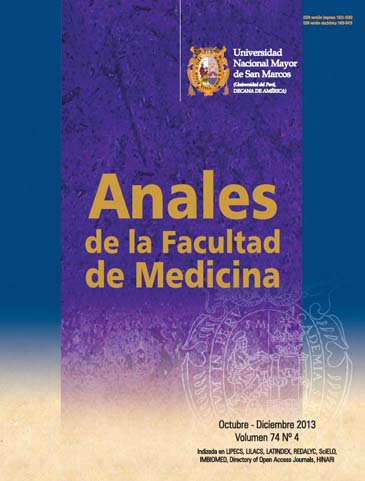Two-hour hyperoxia following experimental neonatal asphyxia produces morphological brain damage
DOI:
https://doi.org/10.15381/anales.v74i4.2697Keywords:
Asphyxia neonatorum, hyperoxia, hypoxia-ischemia brainAbstract
Objectives: To determine the effect of 2-hour exposure to 21% O2, 40% O2 and 100% O2 on cerebral morphology in an experimentalmodel of neonatal asphyxia. Design: Experimental study. Setting: Instituto Nacional de Salud del Niño, Lima, Peru. Biologic material:Holtzman albino rats. Interventions: A sample of 120 one week-old Holtzman albino rats (with the exception of the control group)underwent experimental asphyxia by left carotid artery ligation and then exposition to hypoxia (8% O2); thereafter rats were randomlyassigned to one of the following groups: exposition for two hours to 100% O2, to 40% O2, to 21% O2, and a control group (notexposed to experimental asphyxia). Brain damage was determined by brain weight and percentage of microscopic brain area damage.Main outcome measures: Brain damage. Results: Brain weight was lower in animals with experimental hyperoxia (ANOVA, p<0.001).Microscopic damage was more frequent in the group receiving 100% O2 for two hours and with less frequency in the group receiving40% O2 (60% versus 43.3%). The difference was statistically significant (χ2 test: p<0.001). The group receiving 100% O2 had moremicroscopic brain damage (18.3 %) in comparison with the other groups of experimental hypoxia, but the difference was not statisticallysignificant (ANOVA, p=0.123). Conclusions: Following neonatal asphyxia 100% two-hour hyperoxia was associated with less brainweight and more damage in experimental animals.Downloads
Published
2013-12-30
Issue
Section
Trabajos originales
License
Copyright (c) 2013 Melva Benavides, Roberto Shimabuku, Arturo Ota, Sonia Pereyra, Carlos Delgado, Víctor Sánchez, Graciela Nakachi, Pablo Velásquez, Flor Cruz

This work is licensed under a Creative Commons Attribution-NonCommercial-ShareAlike 4.0 International License.
Those authors who have publications with this magazine accept the following terms:
- Authors will retain their copyrights and guarantee the journal the right of first publication of their work, which will be simultaneously subject to Creative Commons Attribution License that allows third parties to share the work as long as its author and its first publication this magazine are indicated.
- Authors may adopt other non-exclusive licensing agreements for the distribution of the version of the published work (eg, deposit it in an institutional electronic file or publish it in a monographic volume) provided that the initial publication in this magazine is indicated.
- Authors are allowed and recommended to disseminate their work over the Internet (eg: in institutional telematic archives or on their website) before and during the submission process, which It can produce interesting exchanges and increase quotes from the published work. (See El efecto del acceso abierto ).
How to Cite
1.
Benavides M, Shimabuku R, Ota A, Pereyra S, Delgado C, Sánchez V, et al. Two-hour hyperoxia following experimental neonatal asphyxia produces morphological brain damage. An Fac med [Internet]. 2013 Dec. 30 [cited 2025 Jun. 7];74(4):273-7. Available from: https://revistasinvestigacion.unmsm.edu.pe/index.php/anales/article/view/2697



